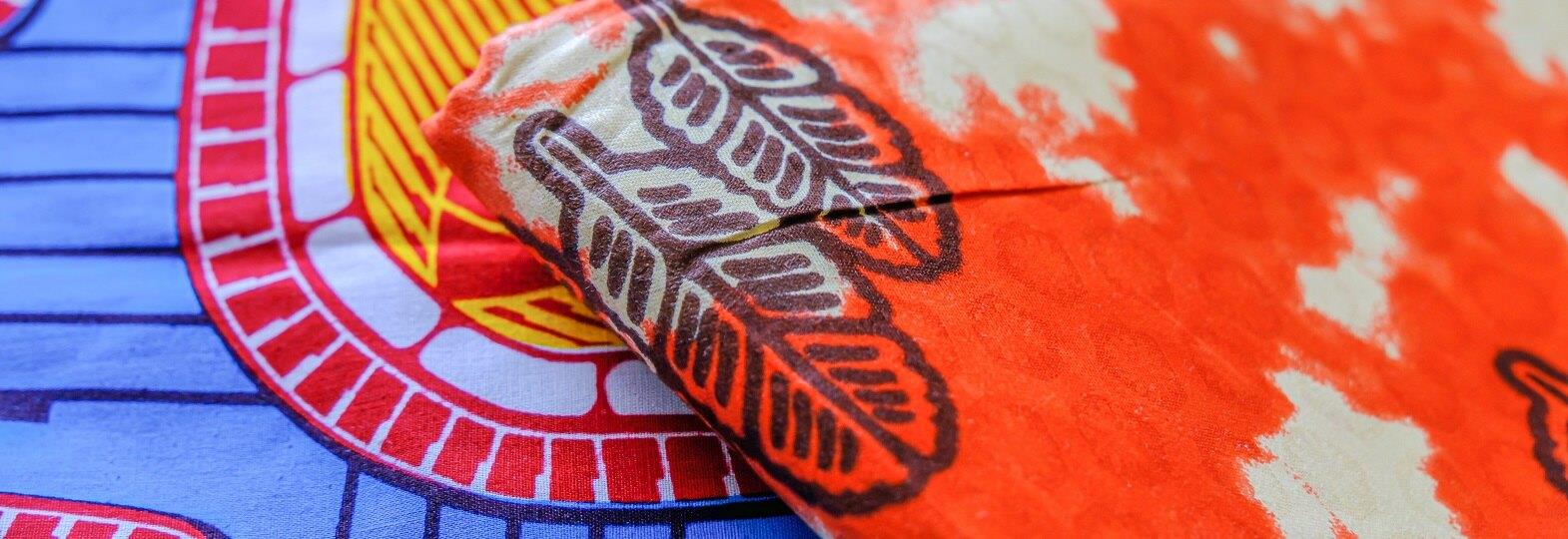The artistry involved in creating, designing, and embroidering traditional African textiles stretches back to the earliest days of human civilisation. Serving as historical records, these textiles reflect the rich tapestry of the African continent.
Hailing from 54 nations and over 3,000 ethnic groups, African weavers and artisans have been fashioning garments for more than a millennium. Such cloth can be used to pay tribute to a specific individual, commemorate an occasion, or even express a political stance. Frequently at the heart of celebrations and ceremonies, textiles have also been employed as a vehicle to convey critical cultural information.
History of African Fabric
African fabric production has roots dating back to 5000 BC in Ancient Egypt, where flax was woven into linen. The textile industry in North Africa flourished with the cultivation of raw materials such as tree bark, animal hides, cotton, palm, jute, flax, and silk. Before the Dutch introduced Ankara (a form of batik) and the French brought in Shweshwe (a variety of tie & dye), Africans used mud and texture to create simple patterns, paving the way for an African textile revolution.
One of the most notable African textiles is the Dutch Wax Print, often referred to as Ankara. The Dutch learned the craft of batik during their colonisation of Indonesia and brought Ankara to West Africa. Large-scale production of wax prints commenced in factories across the Netherlands and other parts of Europe. However, the Javanese preferred hand-crafted authentic products, which led to these European-made fabrics never fully gaining popularity in their intended Asian market.
In the early 1800s, the Dutch introduced the materials they had to the African countries along their trade routes. During this period, African soldiers who were Dutch recruits began returning home with gifts of cloth. The unique, beautiful fabric was readily accepted by West African nations, and, over time, it became an integral part of their own culture, primarily because there was nothing else quite like it.
Although we associate this fabric with Africa, it was not initially created or designed there. The Dutch controlled its production, ingeniously redesigning it using African folktales, fables, and customs narrated by local shopkeepers and artisans. This reimagining turned the fabric into a print that evolved into an unspoken language. The Africans embraced the idea of using art as a discreet form of communication within tribes, nations, and amongst women, often discussing taboo subjects.
The prints formed a visual language that extended throughout Africa. They marked festivities and rites of passage, conveyed various messages, and represented emotions. Recognising that authenticity was key to the appeal of African prints and textiles (a lesson learned from their failed attempt to reproduce the method for the Asian market), the Dutch tapped into African culture to make the fabrics come alive and resonate with the people of Sub-Saharan Africa. This quickly popularised the fabric, and it earned the moniker ‘African Print’ because it connected people to politics, religion, and culture.
In examining African designs and fabrics, we can draw many cultural comparisons. Though cotton and silk form the majority of the base materials, the designs ultimately determine the origins of the fabrics.
Origin of African Fabrics
African fabrics are celebrated globally for their bold designs, innovative patterns, and unabashed use of vibrant colour palettes. Steeped in rich culture, history, and traditions, these fabrics reflect the essence of life and infuse everyday existence with vitality, much like their Asian counterparts. The influence of African textiles is evident in fashion and interior design trends worldwide.
As previously discussed, the history of the African textile industry traces back to 5000 BC, when ancient Egyptians began cultivating flax and weaving it into linen. A 12th dynasty artwork from the tomb of Khnumhotep (circa 2400 BC) depicts weavers using a horizontal loom, a scene captured on ancient pottery found in Badari. Cloth-draped Egyptians are vividly portrayed in pyramids, artworks, and hieroglyphs.
Even the Egyptians’ southern neighbours, the Nubians, had a thriving textile industry, as evinced by the sculptures of the great queen Amanishakheto, pharaoh Piye, and the Meroitic pyramids.
Later, as various civilisations developed in Africa, cotton began to be widely used as a textile. According to traveller Ibn Battuta, weavers existed in Timbuktu and the Mali empire in the 1300s. As Islam spread to West Africa, many people began wearing the boubou, a traditional long robe.
Today, a rich textile heritage thrives across Africa. The hand-woven Bogolan, commonly known as ‘mud cloth,’ has its origin in Mali. Ghana’s national fabric, the kente cloth, was historically so costly that only royals could afford versions woven with gold threads. Legend has it that British explorers were astounded by the splendour of an Ashanti king’s attire. In Cameroon, there is a long-standing tradition of fabric made from tree bark, with some textiles specifically made from obom. Raffia fibres continue to be used to make clothing and bags.
Additionally, kings in West Cameroon wear exquisitely woven clothes crafted by the country’s finest weavers and adorned with beads. People in Chad and the Central African Republic use a variety of natural colours to weave cotton strips on horizontal looms, while the Pygmies use bark cloth made from tropical fig trees.
The Kuba people of the Democratic Republic of Congo use raffia to create some of the most beautiful handwoven sculptures, clothes, and blankets. The Ndebele people of South Africa and Zimbabwe uphold a long tradition of producing stunning, vibrant quilts and blankets entirely by hand. Many would admire the elegance, colour, and presentation of well-dressed Ndebele women.
Popular textiles of Africa
1. Kuba Cloth
These textiles are made from palm fibres by the inhabitants of the Bakuba kingdom, which was located along the river Kasai in the modern-day Democratic Republic of Congo. Traditionally, they were utilised for royal garments and mats. Artists like Matisse and Picasso were inspired by the patterns on the fabric in the early 20th century.
2. Ase Oke
The term Ase Oke, originating from the Yoruba phrase meaning “greetings on the spending of money,” is the name given to a special fabric in the Yoruba culture. This fabric is woven exclusively by men using small strip looms and materials like cotton or silk. Ase Oke holds great significance to Yoruba men and women, bestowing both aesthetic appeal and social status on the wearer and the weaver.
This exquisite fabric, crafted by Yoruba men in Nigeria, came into prominence particularly during World War II when imported lace from England became unavailable. To compensate, intricate lace-like designs were incorporated into the weaves, a distinctive feature that is often showcased in Ase Oke. Some designs also employ metallic threads in gold and silver. Both men and women don the Ase Oke, amplifying its cultural significance.
Popular Ase Oke styles include:
• Alaari: This is a rich, red Ase Oke, often worn on special occasions.
• Sanyan: This Ase Oke is brown, typically light brown in colour, and is a common choice for various events.
• Etu: This dark blue Ase Oke is another popular style regularly adorned by Yoruba people.
3. The Okene Cloth
The Okene Cloth is a type of woven textile created in the Nigerian village of Okene. Unlike the Ebira men, who weave on small portable looms outdoors, the Okene is considered a “prestige” cloth made by Ebira women using large stationary looms inside their homes. Many modern weaves incorporate metallic gold or silver threads, lending a beautiful sheen to the fabric.
These textiles enhance the status of the women who wear them, often as headwraps or wraps. They also bring prestige to the weavers and dyers who create them.
4. Kente Cloth
Kente is arguably the most famous and intricately woven of all African textiles. This fabric is crafted by men using a combination of small hand and foot looms. Traditionally, it is worn by the Ashanti royal family during ceremonial occasions such as ‘stooling’, a ceremony symbolising ascension to kingship.
The striking colours and geometric patterns of Kente cloth serve as the perfect complement to the magnificent gold ornaments and the renowned golden stool that the Ashanti display during royal events.
Kente is woven by Ashanti men into long, narrow strips, which are then stitched together to create a breathtaking fabric. Originally, silk was used in its weaving, specifically for the Ashanti aristocracy.
5. Adire Cloth
Adire, a term in the Yoruba language, literally translates to “tie and dye”. This refers to one of the most recognised fabrics in Africa, the indigo-dyed cloth, traditionally worn only by women. Adire cloth features a batik-like pattern on starch-resist cotton fabric. The artist Niki Seven has been at the forefront of efforts to revive the traditional art of Adire.
New techniques of resist dyeing emerged in the early 20th century, most notably the practice of hand-painting patterns on the fabric with a cassava starch paste prior to dyeing. This method was referred to as Adire Eleko.
Adire is known for its indigo-dyed textile produced by Yoruba women in southwestern Nigeria using a variety of resist dyeing techniques. The earliest textiles were likely hand-spun cotton fabrics that were locally woven with simple knotted motifs, similar to those still produced in Mali.
6. Bokolonfini
The term ‘mud cloth’ refers to the strip-woven cotton fabric known in the Bambara language as ‘bokolonfini’, crafted by men in Mali. The creation process involves first soaking the fabric in a dye derived from bark and leaves. Afterwards, a design is painted on using thick mud, rich in iron acetate, which is collected from lake bottoms.
Contemporary interpretations of this cloth feature innovative designs, typically in black, gold, brown, and off-white hues. These colours have resonated with international audiences, creating a significant export market, particularly popular among interior decorators.
7. Adinkira
Adinkira is a fabric hand-printed using stamps made from the thick rind of a calabash (gourd). Each stamp carries a meaning tied to a proverb, allowing the wearer to ‘read’ the print. It is a royal cloth of the Ashanti people, typically paired with ‘Kente’ for occasions such as funerals (especially the black cloths), ‘stoolings’ (inaugurations), and other royal events. Adinkira fabrics feature vibrant multi-coloured hand embroidery along every seam. Modern Adinkira fabrics often showcase machine embroidery on the seams.
Current Demand of African Traditional Textiles
African textiles, fabrics, and fashions have been globally distributed for centuries through networks of growers, artisans, and merchants, leveraging fibres like cotton, as well as the bark and leaves of various plants and the colour dyes derived from them. Traditional African textiles, produced from natural fibres like cotton, are worn to display status and wealth. On the other hand, technical African textiles are crafted from natural and engineered materials for specific purposes, such as insulation, conductivity, or fire resistance.
Cotton is one of the most important fibres used in African textiles, serving as a significant crop for domestic consumption and a crucial export for several countries. Both organic and genetically modified forms of cotton are cultivated on the continent.
The current generation of designers is embracing digital, 3D, and other technologies to adapt indigenous production methods and handcrafting skills for the fabric and fashion emerging from Africa. African clothing flourishes in urban markets across the continent, where woven and commercially created prints are sold side by side, supported by a network of interconnected weavers, buyers, and sellers.
According to Statista, the market volume is predicted to reach $6,182 million by 2027, with revenue expected to grow annually at a rate of 13.23 per cent (CAGR 2023–2027).1 A significant market segment is created by e-commerce through distribution channels like online stores. The rise in the African clothing market’s sales is primarily attributable to the expanding middle class in East and Southeast Asia, who use social media and mobile apps for online shopping.
The African clothing market is mainly composed of cotton fibres. Uganda, Benin, Ethiopia, Mali, Egypt, Tanzania, Senegal, Burkina Faso, and South Africa are among the African countries that produce fibre for both domestic use and export, with the majority going to China, India, and the United States. Sub-Saharan Africa ranks fifth in global cotton production, accounting for 7.1 per cent of the total. Many nations in Africa are ideally suited for cotton production due to their mild climates.
In 2005, the World Trade Organisation relaxed restrictions, granting African textile manufacturers access to markets in Europe and Asia. As a result, global demand for African fabrics, clothing, and fashion has increased considerably and is expected to remain robust. African garment manufacturers now enjoy improved working conditions, due to lower wages for textile workers in Africa than in Asia and enhanced shipping in countries like Ethiopia.
Ending Note
The prosperity of Africa’s economy hinges significantly on the textile industry. The primary catalysts for the development of Africa’s burgeoning textile sector are foreign investment, investor confidence, and the growth of the fashion industry. Over the last two decades, China has emerged as a significant source of finance for African economies, particularly for Ethiopia’s young yet rapidly expanding manufacturing sector.
The level of engagement from African nation governments remains the primary challenge. Therefore, political will and an enhanced business climate are two factors that would spur increased competition and promote the growth of the industry.











Comments